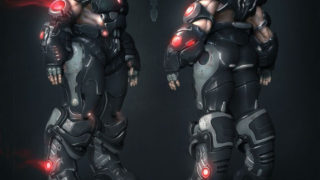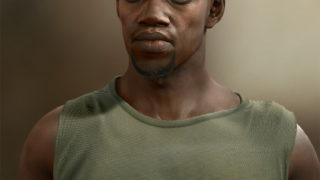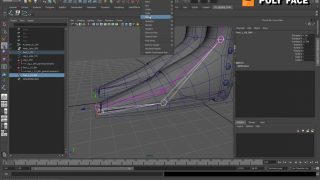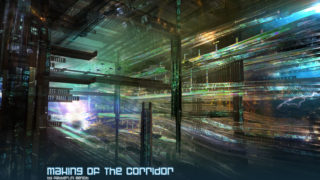
Making of ‘Call of Cthulhu’
This illustration is inspired by the short story Call of Cthulhu by Lovecraft. There is plenty of amazing Cthulhu art around and I’ve always been fascinated by the subject so I decided to do my own version of it. It’s based on the part of the story that describes how the sailors accidentally manage to free Cthulhu in the nightmare city of R’lyeh.
Introduction
His tomb is described to be a “monstrously carven portal” and Cthulhu itself as being an entity of cosmic evil, the size of a mountain, that looks like a cross between a human, an octopus and a dragon (Fig.01).

STEP 1
The first thing I was concerned with was the creature design and the colossal scale it had to convey. To do this some good results can generally be achieved by adding a scale reference. For example, it could be a person, doors/windows, birds flying etc. Because we know how big all those things are, when we put them next to our subjects it gives a sense of scale that would otherwise be difficult to convey.
The use of perspective with a really zoomed out field of view or a fisheye lens effect also affects perception of scale. Another very helpful thing is cutting something off the frame. The viewer will perceive a subject to be huge if it cannot even fit into the picture; it implies there’s so much out there and leaves something to the imagination, which is generally a pleasing effect anyway. In this case you can only the pretty big head so we assume the full body must be enormous.
After a quick exploration on paper I moved to Photoshop for this sketch. Most important problems are solved at this stage: composition, rough perspective, patterns of light and darks, big shapes vs. details and so on. I generally leave the color to a later stage (Fig.02).

STEP 2
I was happy with the sketch so I started solving the beast design and working up some values. I added a few more tentacles around and started to get a feel for the surface and details of the head. As I did this, I kept an eye on the flow of the lines making sure they led to the face which was going to be one of the major focal points. I imagined the body to be a crab-like surface and worked on the arm and claws to get a similar look.
I did a quick test to see what it would look like if his arm had already hit the ground, but I wasn’t too happy with it. We tend to perceive a lot more tension just before an action happens so I reverted back and worked on the claws to make them more interesting (Fig.03).

STEP 3
Then I started scribbling around the walls to suggest they were covered in hieroglyphs and carvings. The tomb itself had to maintain the theme that something terrible was trapped inside.
The main upper shape is essentially composed of inverted triangles; in psychology of shapes, things that can hurt you like sharp and pointy forms tend to be perceived as evil, as opposed to round and soft ones. Triangles, particularly inverted triangles, are the simplest shapes that oppose round “good” forms, so that was a base for the design. I could have overdone it and put spikes everywhere but I wanted to convey the feel of an old temple made of giant stones, highly decorated, but at the core very rough and functional, in a way similar to ancient Egyptian architecture.
I thought about the façade resembling a stylized octopus head when the portal is closed, those eye-like black holes helped a lot to keep the setting more menacing. The columns on the side re-establish the vertical three-point perspective; they frame the scene and help give the impression that we are looking at something very tall.
The face didn’t look evil enough so I added the horns and there’s a bit of symbolism with the goat-like ears to echo the inverted pentagram and sigil of Baphomet, since it is typically associated with evil (Fig.04).

STEP 4
To get some color I used the texture of a stone wall in Overlay mode on top of the grayscale, making sure the bricks followed my perspective by using the Distort and Perspective transform tools. Then I softened it out by erasing or painting on top. At this point I also reassessed the lighting and worked on the contrast by duplicating the image, putting it in a Multiply layer and erasing out the parts I wanted to stay brighter.
I also turned the hieroglyphs into something more meaningful, using them to add something to the story (Fig.05). I thought it would be cool if the tomb was built in a way that allowed humans to kill Cthulhu and left a hint of it in the carvings. The upper middle section in between the eye-like holes is actually some kind of spear that when activated falls down and is capable of killing Cthulhu.

STEP 5
So from the bottom one to the top they represent: the arrival of Cthulhu on earth and people idolizing him, the building of the tomb, Cthulhu being imprisoned inside, the stars aligning, Cthulhu being killed by the spear just as he is freed. Little things like this are very fun to do; they add a bit more mystery or depth to the storytelling and can be an extra reward for a careful observer.
In this final step, I worked on the floor and rendered the puny humans, finalized the lighting with cast shadows and added a bit of motion blur to its arm to suggest movement. You can see a few more steps in between here (Fig.06)

And here’s the final image (Fig.07).

It was lots of fun to work with such cool subject. I hope you enjoyed this overview, if you have any questions feel free to drop me a mail at oblishar@gmail.com. I’m always available for freelance, commissions and new job opportunities so if you’re looking for a concept or 3D artist please get in touch.








